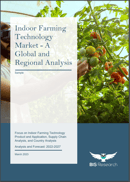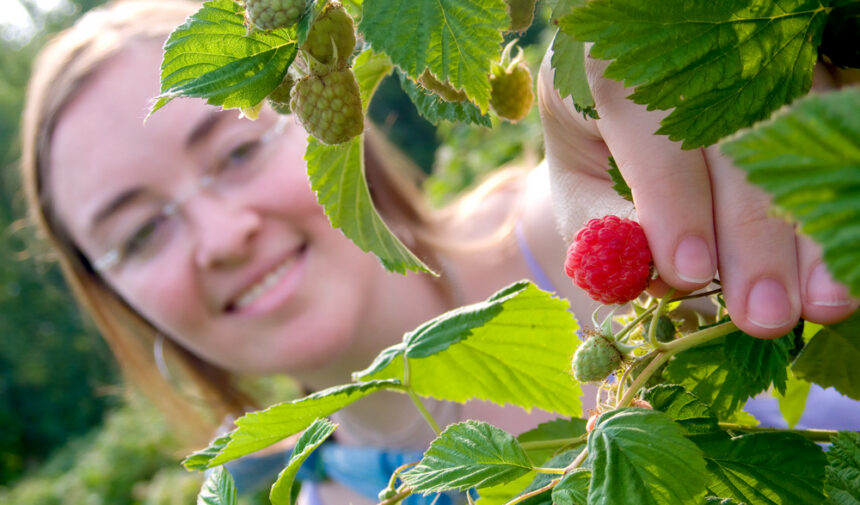 With the rise of the global population, the need for food has grown exponentially, revealing the shortcomings of traditional farming methods. Climate change, soil degradation, and water scarcity are just a few of the challenges that farmers face today.
With the rise of the global population, the need for food has grown exponentially, revealing the shortcomings of traditional farming methods. Climate change, soil degradation, and water scarcity are just a few of the challenges that farmers face today.
This has encouraged the widespread adoption of indoor farming, a novel technique for cultivating crops in a regulated environment, often without soil, using advanced technologies to optimize growth.
Indoor farming has been in practice for thousands of years, with early civilizations like the Babylonians and Egyptians implementing hydroponic systems to grow crops in water.
However, it was not until the mid-20th century that indoor farming began to take off in a significant way.
In 1929, Dr. William Frederick Gericke, a plant nutritionist from the University of California, announced the development of hydroponics, an indoor farming method that involved growing plants in a nutrient-rich water solution without soil.
From there, indoor farming continued to evolve, with researchers and entrepreneurs experimenting with new technologies and approaches to growing crops.
Today, indoor farming is a rapidly growing industry, with various farms operating in cities around the world as a sustainable and efficient way to grow food in the face of various environmental challenges. According to data insights from BIS Research, the global indoor farming technology market was valued at $5.84 billion in 2022 and is expected to reach $17.12 billion in 2027, following a CAGR of 23.99% during 2022-2027.
This blog post delves into the progress of indoor farming while shedding light on the latest trends and technologies that have transformed the industry.
Rise of Vertical Farming
Vertical farming is one of the most prominent forms of indoor farming being implemented in modern times. It involves growing crops in vertically stacked layers, using artificial lighting and a controlled environment.
Vertical farming offers several advantages over traditional farming methods, including higher crop yields, reduced water usage, and the ability to grow crops throughout the year.
Furthermore, this approach allows for a significantly higher yield per square foot of land, making it an attractive option for urban areas where space is at a premium.
Numerous instances of thriving indoor vertical farming exist around the world, which are as follows:
AeroFarms is an agriculture company based in Newark, New Jersey, and has achieved tremendous success in indoor vertical farming through its fully-controlled environment.
Its operations include a range of advanced technologies such as custom lighting arrays, automated nutrient delivery systems, and custom HVAC and building design.
This allows AeroFarms to grow crops all year round without using pesticides, herbicides, and fungicides, leading to food safety.
AeroFarms also uses its proprietary aeroponic technology to mist the roots of its plants with targeted nutrients, water, and oxygen. This closed-loop system uses up to 95% less water for leafy greens than field farming and even less for hydroponics, as well as a fraction of the fertilizers.
Moreover, AeroFarms’ growing system features a patented growing cloth medium, which acts as a barrier between the mist and the plants, keeping the plants clean and primed for eating without the requirement of washing.
This cloth is a highly flexible growing medium that allows AeroFarms to grow hundreds of different varieties of leafy greens, making it highly market-driven with its product offerings.
Furthermore, with the integration of the Internet of Things (IoT), AeroFarms is progressing toward the establishment of fully connected vertical farms.
Eden Green Technology is a leading provider of sustainable agriculture solutions based in Texas, U.S., and specializes in vertical farming.
Eden Green implements controlled environment agriculture (CEA) to grow crops, using indoor farming growing methods such as hydroponics and aeroponics.
Moreover, its innovative approach involves the use of advanced technologies such as patented microclimates, proprietary mobile light bars, and hyperresponsive mechanical, electrical, and plumbing (MEP) containers.
Its patented microclimates technology is designed to create a more efficient and zero-waste personalized incubator for each plant grown in its greenhouses.
Each plant’s roots receive a precise nutrient mix through a temperature-controlled and filtered closed-loop water system every 90 seconds, resulting in faster and higher quality harvests with less waste.
The microclimates also allow for responsive air control for oxygen and carbon dioxide, which can be adjusted for temperature and humidity in seconds.
By focusing on the area around each individual plant, Eden Green is able to grow more than 200 products in one vertical farm, saving energy and allowing for multi-crop cultivation.
Its proprietary mobile light bars technology provides quality supplemental lights to the plants when and where they require it, resulting in consistent weight and higher quality products.
Furthermore, the mobile light bars have resulted in a 60% increase in yield using 90% less light energy than other vertical farms.
The MEP containers allow for the growing of tropical or cold weather plants without compromising product quality or system efficiency by ensuring exact temperature control and removing vulnerabilities associated with extreme cold or heat.
Plenty is based in San Francisco and has developed a vertical farming system that uses machine learning algorithms to optimize growing conditions, with yields of up to 350 times more produce per acre than traditional farming methods.
The system uses LED lights to mimic natural sunlight and precise nutrient delivery systems to ensure that each plant gets exactly what it needs to grow.
Moreover, Plenty is able to reduce the amount of land required for food production, freeing up space for other uses such as wildlife habitats or recreational areas.
This approach also helps to reduce monoculture farming practices, which can have negative impacts on soil health and biodiversity.
Moreover, sustainable approaches such as the above are creating food products with higher yields as compared to traditional farming technologies and driving consumer demand, leading to growth in the market.
Emergence of Smart Farming Technologies
Smart farming technologies, such as sensors, AI, and automation, are increasingly being used in indoor farming operations to improve crop yields, reduce waste, and minimize environmental impact.
Agriculture sensors monitor a variety of factors, such as temperature, humidity, and nutrient levels, providing growers with real-time data on the health of their crops. This data can be used to adjust the growing environment, such as lighting or nutrient levels, to optimize growth and maximize yields.
Furthermore, artificial intelligence (AI) algorithms analyze vast amounts of data from agriculture sensors and other sources to identify patterns and optimize growing conditions. For example, AI can help growers predict when pests or diseases are likely to occur, allowing them to make informed mitigating strategies.
Automated systems can perform tasks such as watering, fertilizing, and harvesting, reducing the need for manual labor and increasing efficiency. For example, agriculture robotics can be used to pick and package crops, reducing the need for human labor and minimizing the risk of contamination.
For instance, Bowery Farming, based in New York, leverages a combination of sensor and AI technology in its indoor vertical farms to enhance crop growth and health.
One of Bowery Farming’s most notable achievements is the release of its delicious and sustainably-grown strawberries, which went on sale in New York City in early 2022.
These strawberries are grown using Bowery’s proprietary indoor farming technology, which uses 95% less water than traditional farms and produces 100 times more crop yield per square foot.
The BoweryOS acts as the core system of each farm, gathering information from sensors and cameras to create customized crop recipes that incorporate factors like light spectra, photoperiod, humidity, temperature, and nutrients. These crop recipes are continually refined by machine-learning algorithms to enhance crop yield and health.
Moreover, AI also assists Bowery in managing its resources efficiently. It works in conjunction with its agritech systems to optimize the use of purified water and enhance sustainability by regulating energy consumption.
Production of Lab-Grown Meat
Indoor farming is not limited to the production of fruits and vegetables. Now, it can also be used to produce meat using lab-grown technology.
Lab-grown meat, also known as cultured meat, is produced through cell culture rather than traditional animal agriculture, which involves taking a sample of animal stem cells and using them to grow muscle tissue in a lab setting.
The resulting product is biologically identical to traditional meat but with a much lower environmental impact and without the need for animal slaughter.
Vertical farming plays a major role in the creation of cultured meat by providing a controlled environment to grow the necessary animal cells.
The process involves growing animal cells on a scaffold in a bioreactor, which can be housed in a vertical farm. The bioreactor provides the ideal conditions for cell growth, such as temperature, humidity, and nutrient supply, which can be carefully regulated in a vertical farm.
Moreover, the closed environment of a vertical farm also minimizes the risk of contamination, which is crucial for ensuring the safety and quality of the cultured meat produced.
Vertical farms can also potentially provide a more sustainable source of nutrients for the cell culture medium, such as algae or other microorganisms that can be grown within the farm.
For instance, Mosa Meat, a Dutch food technology company, is developing cultured beef in indoor vertical farm settings. Interestingly, the Mosa Meat team created the world’s first cultured meat hamburger.
Similarly, Memphis Meats, a California-based company, is working on cultured chicken and duck and has received funding from investors such as Bill Gates and Richard Branson.
Conclusion
With the world’s population expected to reach 9.7 billion by 2050, indoor farming can help meet the growing demand for food while reducing the environmental impact of traditional farming methods.
Advancements in technology and techniques such as automation, vertical farming, and artificial intelligence are making indoor farming more efficient, cost-effective, and scalable.
Moreover, the use of blockchain technology in the food supply chain can provide greater transparency and accountability, ensuring the safety and quality of the food one eats.
As indoor farming continues to evolve and become more accessible, it offers exciting opportunities for farmers, entrepreneurs, and consumers alike.
Learn More
 For more information on this fast-growing market, please see Indoor Farming Technology Market – A Global and Regional Analysis, a detailed report packed with data and insights covering indoor farming market segmentation, recent market developments, market demand, drivers and challenges, the competitive landscape, and key players. This report draws on extensive primary and secondary research to help industry players design the right business strategies for this competitive, ever-shifting market.
For more information on this fast-growing market, please see Indoor Farming Technology Market – A Global and Regional Analysis, a detailed report packed with data and insights covering indoor farming market segmentation, recent market developments, market demand, drivers and challenges, the competitive landscape, and key players. This report draws on extensive primary and secondary research to help industry players design the right business strategies for this competitive, ever-shifting market.
About the Publisher: BIS Research is a global market intelligence, research and advisory company that focuses on emerging technology trends that are likely to disrupt the market. Its team includes industry veterans, experts, and analysts with diverse backgrounds in consulting, investment banking, government, and academia.







